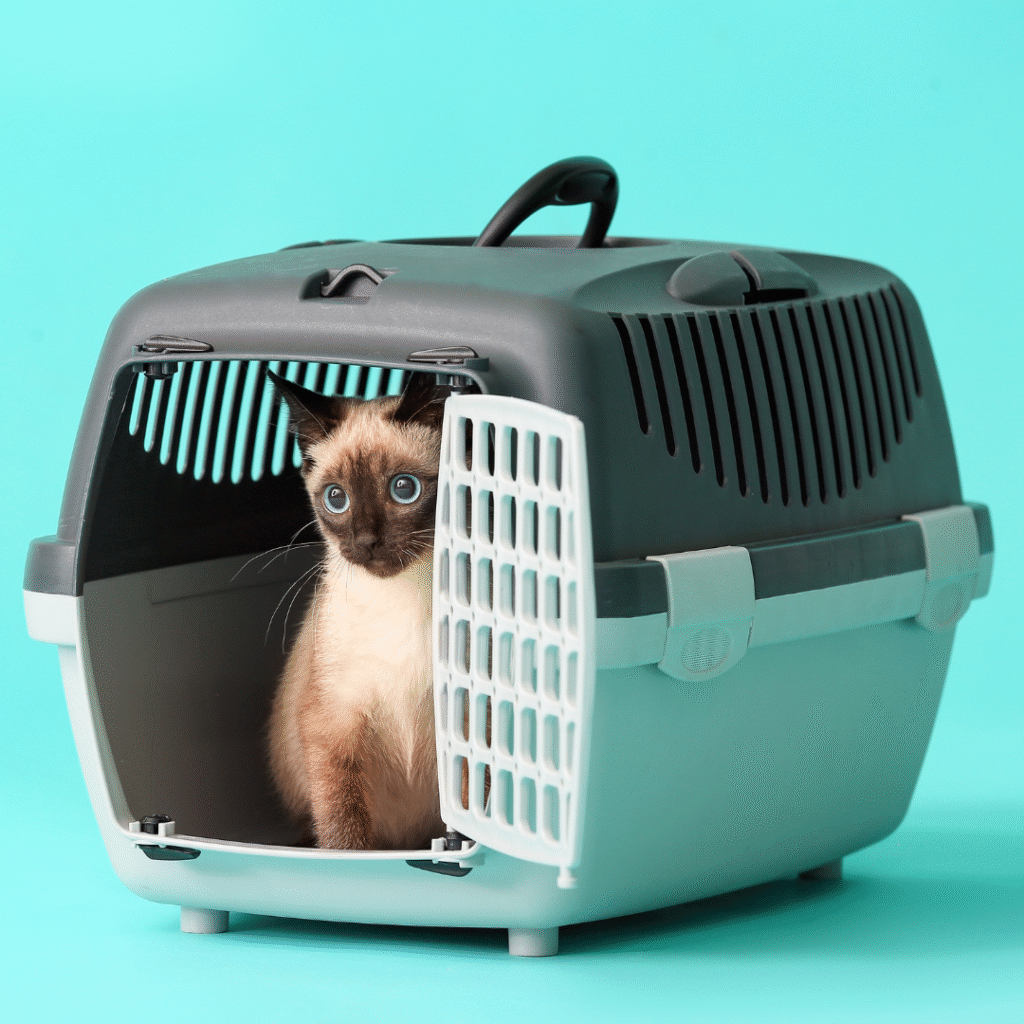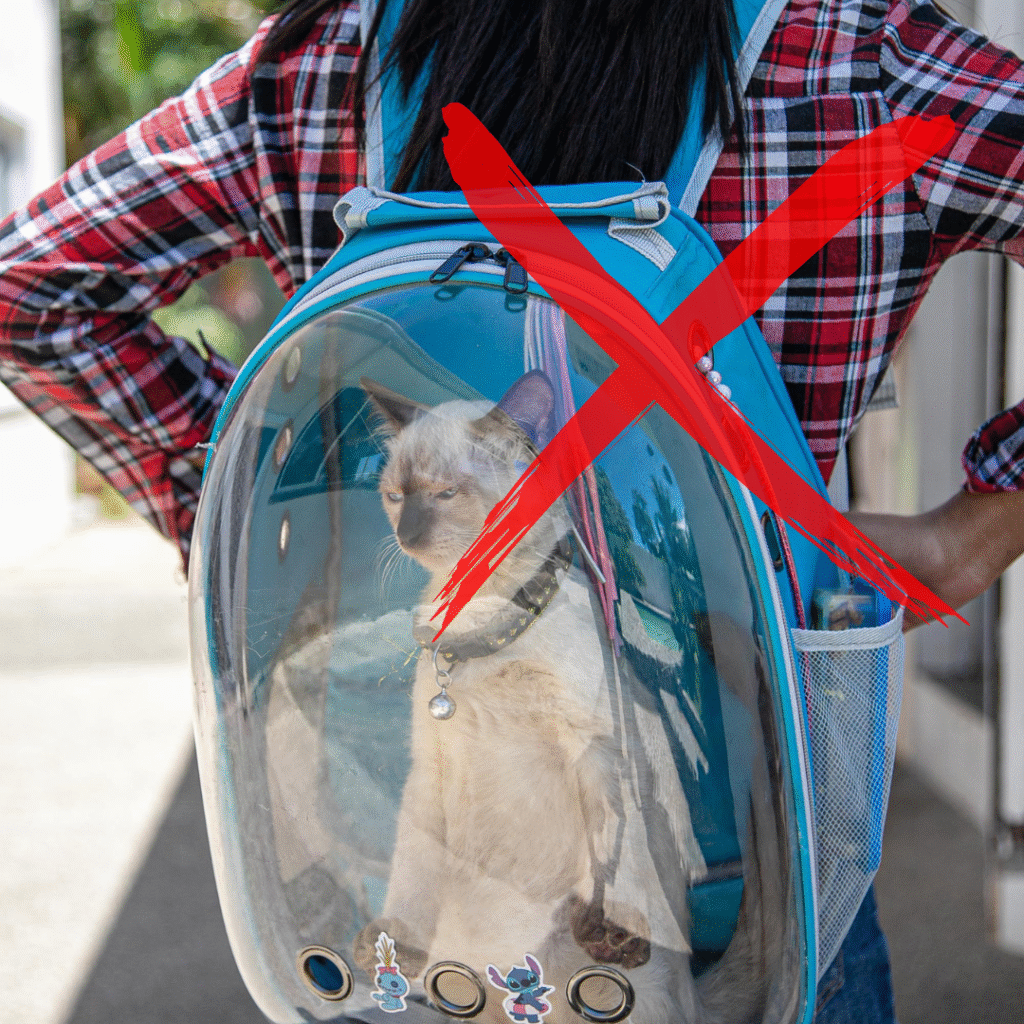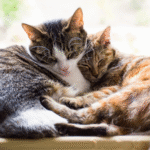Hi fellow cat lovers, this sounds like a perfect time to follow up from the previous informative article, From Fear to Comfort: Teaching Your Cat to Love the Carrier.
Let’s be honest, not all of us love a thrilling roller coaster. In fact, most of us prefer our commute not to feel like a rickety old amusement park ride that throws us around—especially when we’re going to get off and feel very unstable in the environment. Maybe even fearful, after a terrifying and cramped, unpredictable ride that spits us out feeling discombobulated amongst strange people, smells, and loud noises.
Since we successfully conquered the fear of the carrier last month, now it’s time for the next steps: making the journey itself smooth sailing for our cats. After all, the carrier is not just a box; let’s see it as a first-class ticket with lots of leg room.
In those moments, we must put ourselves in that position. Remember the old scary movies where the good guy is shoved into an area blindfolded, and they have no idea where they’re going or what’s going on? Maybe a stressful car ride to an unknown location—fear and anxiety, right?
Well, that might be going overboard a little bit, but I just want you to get the idea. It’s no different for them. In fact, maybe even more terrifying because their home environment is all they know.
After all our hard work last month getting comfortable with the carrier itself, the last thing we want to do is set them back by choosing a carrier that is more of a jail cell rather than a soft, cozy den. We want to make sure their journey is as peaceful as possible.
Let’s go through some of the options for carriers. Ultimately, you will make the best decision given this knowledge.

The Gold Standard: Hard-Sided Carrier
This is the winner for safety, durability, and everyday situations, especially for car travel and vet visits.
Pros
• Protection & Durability: The heavy-duty, solid plastic provides the best defence in case of an accident or impact. They won’t collapse.
• The Top-Loading Advantage: This is excellent for vet visits. They allow the cat to be placed in vertically under emergency circumstances, which could lead to less fussing; and at the vet they can often perform a full exam—or at least the initial assessment—when the cat is still sitting comfortably in the bottom half of the carrier. This means less stress, fewer escapes, and a happier cat and happier human! The best styles are ones where the entire top unscrews or unlatches from the bottom. (Another reason why cradling the carrier can be important—making sure that bottom is in safely and securely.) Always diligently triple-check that the bottom is secure before leaving your home, the vet, etc.
• Hygiene: They are super easy to clean and disinfect. Perhaps kitty is having an uncomfortable day where an accident happens—car sickness, stress urination—it’s easy enough to wipe down. Also great for removing the smell of the hospital when comfortably back at home.
• Security: Difficult for those escape artists to break out of. Some soft-sided carriers have the top-loading aspect with just one little notch where they can stick their head through, or perhaps the zipper is not securely done up.
Cons: They’re bulky, can be heavy, and are a pain in the butt to store. Very important to add a comfy bed or blanket because the bottom of this carrier is cold and hard.
The Sometimes-Necessary Compromise: Soft-Sided Carrier
These have a specific and essential purpose but come with some caveats.
Pros
• Airline Travel: When travelling onboard with your cat, airlines have specific rules for dimensions and flexibility for in-cabin carriers. These can meet the strict “under the seat” requirements. They are also much lighter to carry through the airport.
• Comfort and Portability: Soft-sided carriers often come with built-in padding, making them great for short, stress-free trips (assuming your cat is calm).
Cons — The Compromise
• These carriers often offer less protection in a bump or an accident, and they can collapse. They are also less secure, as determined cats can sometimes work a zipper or shred the panels. And yes—if they pee, poop, or bring up their lunch—you’re washing the whole carrier.

The Less Desirable and Unsuitable List (Cats say: “No thanks! Hard pass.”)
- The “Human Preference” Backpack Carriers: These are a poor choice for stability and security. Cats are left to feel extremely vulnerable when being carried vertically on someone’s back (a very awkward position for a prey/predator species). The consistent bouncing and swaying can cause major motion sickness and spike their stress levels. These are for human convenience—not the cat’s well-being.
- The Disposable Disaster: Cardboard Carrier: Flimsy and not secure at all. These can disintegrate with one bathroom accident or in bad weather. They should only be used as a one-time, emergency option—such as leaving the shelter or vet—but never as routine.
- The Rollercoaster: Rolling Carriers: Yes, okay, these can be great for humans who can’t carry weight, but the motion of being wheeled across bumpy pavement can be terrifying and disorienting for the cat. And good luck trying to get them in it again in the future. If using one, they must be carried very carefully to avoid turning into a not-so-amusing park ride.
Size and Security (The Non-Negotiables)
• Size: Going back to my analogy about legroom—size matters. The carrier must be large enough for your cat to comfortably stand up, turn around, and lie down in a natural position.
• Not Too Big: A common misconception is “bigger is better.” If the carrier is too big, the cat loses that crucial feeling of a secure, den-like space where they feel hugged; and they can slide and tumble around during motion, increasing stress. An easy rule of thumb: choose a carrier about 1.5 times the length of the cat.
Safety Features
• Ever seen a cat turn into liquid in fight-or-flight mode? Ensure all carriers have reliable, lockable latches or zippers.
• Ventilation: Vital. The carrier must have good airflow to prevent overheating and to ensure the cat isn’t breathing stale, anxious air.
• Car Safety: Look for features that allow you to thread the seatbelt through the carrier, or secure it on the floor behind the front seats—my number one choice. This prevents the carrier from sliding or becoming a projectile in a sudden stop.
One Cat, One Carrier (The Golden Rule)
If you’re like me and you have multiple cats, and you try to plan vet visits and travel together, we should talk about the golden rule: one cat, one carrier. While it may seem comforting for bonded cats to share space, data and behavioural studies overwhelmingly recommend individual carriers.
Why Separate Carriers Are Best:
• Prevents redirected aggression: Stress is cumulative. The moment a cat is stressed by a car ride, a smell, or a barking dog, they are primed to lash out. If two cats are combined, they may redirect their fear-based aggression toward their bonded friend—this is known as non-recognition aggression.
• Maintains positive scent associations: Cats identify each other largely by scent. If one cat is extremely fearful or eliminates in the carrier, and the other is trapped next to them, the second cat now associates that fear scent with their roommate.
• Easy, stress-free handling: Veterinarians cannot easily examine two cats in one carrier. They must be dragged or forced out one by one. Having them in separate carriers means the vet can simply unsnap the top of a hard carrier and examine one kitty at a time while they stay safe in the bottom half.
A Recommended Triage Plan (Most Common Two-Cat Scenario)
This approach minimizes the time any one cat is left alone and unmonitored.
- Cat A: Leave kitty securely buckled in their carrier in the car, preferably with the carrier door facing away from the closest exit door, with the towel or blanket still draped over it.
- Cat B (first in): Remove this cat’s carrier and use the level-load technique (carrying the carrier close to your body and level to minimize swinging). A luggage strap can help support you as you cradle the carrier.
- The Clinic Hand-Off: Quickly take Cat B inside, check in as soon as possible, and ask the receptionist for the technician to safely hold or immediately place Cat B in the exam room.
- The Swap: Immediately return to the car. Cat A has probably only been left for the moment it took to get Cat B inside and secured. Quickly unbuckle and retrieve Kitty A and bring them into the clinic.
Mobility or 3+ Cats
When you have two or more carriers, it can require some heavy lifting. This can be a physical challenge. Here are some ideas:
• The Rolling Solution Exception: If available, a sturdy flat platform or luggage dolly. You can even purchase those collapsible wagons—these are a game changer. Secure the carriers with a bungee cord or strap to eliminate dangerous swinging that increases feline stress.
• The Car-Side Concierge (My Best Advice): Call ahead as soon as you arrive and ask for car-side assistance. Whoever is available—a veterinary assistant or technician—can come out to safely assist with the transfer. This ensures no cat is left alone, unattended, or at risk of escape.
Ultimately, whether you’re taking care of one cat or five cats, the goal is the same. Let’s avoid these rickety roller coasters of instability for our cats. These safe logistics go closely together with carrier training and trying to create a great experience for your cat—whether it be travel, the veterinarian, or a move. It’s important that we maintain a healthy baseline and not increase their stress (or our own!) in return. The perfect human–cat transport partnership.

Fun Fact
The original hard-sided plastic pet kennels (like the ones you recommend for stability and safety!) were first mass-produced in the late 1960s by Mr. Doskocil, who would later own Petmate.
Having Trouble with Your Cat’s Behaviour? Let’s Chat!
If your cat is trying to communicate and you’re unsure what they’re saying, I’m here to help. Book a free pre-consultation call, and we’ll go over what’s happening and how I can support you. Whether it’s litter box troubles, aggression, anxiety, or something else, we’ll talk about the best steps to restore peace in your home.
Book a Free Pre-Consultation Information Call with Krista, a fear-free, force-free, and positive reinforcement Certified Cat Behaviour Consultant & Fear Free Certified Professional in Ontario, Canada.
Instagram: FelineBehaviourCoach
Facebook: FelineBehaviourCoach









